- Title: Etrian Odyssey
- Platform: Nintendo DS
- Release date: 2007-2008
- Developer: Atlus & Lancarse
- Publisher: Atlus
- How I played it: emulated via melonDS
- How long it took: 99 hours
- Start date: 24/12/2021
- Finish date: 23/01/2022
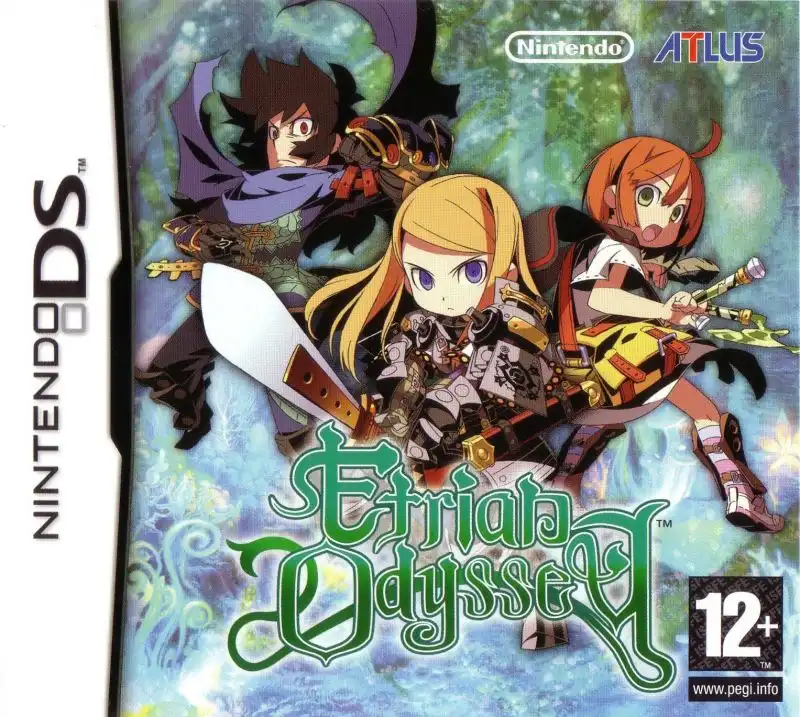
Table of contents
Introduction
Mapmaking resides at the exact halfway point between artistic mystery and pure function. Cartographers toe the line between accuracy, abstraction, representation, and surveyance; they have to master all of these in equilibrium. It's a mix of pure mathematics and artistic skill in order to create a (hopefully) accurate simulacrum of a real world form. It is entirely dependent on the cartographer's skill whether or not the map is useful, and that means the stakes can be high. It's one thing to make a tool that isn't that effective and you can safely discard it or try again later, but another entirely when your life depends on it. Enter: Etrian Odyssey.
Etrian Odyssey is a game series which is all about mapmaking at its core, which is probably what put the game on the map (heh) in the first place. You draw your own map with ingame functions as you navigate dozens of floors of a towering dungeon. You fill in walkable tiles, add the walls, place icons, and then refer to it every time you traverse that section again. Throw in some JRPG turnbased combat and you’ve got a series that knows what is important, and iterates on it. Developed by Atlus and Lancarse on the Nintendo DS and 3DS platforms, they’re heavily inspired by dungeon crawler games of yore; a genre, according to the excellent dungeoncrawlers.org, characterised by its first person perspective, a grid based structure, and orthogonal movement, i.e. you can move forward, backward, left, and right, and turn in 90 degree increments. There is no free flowing movement and you are bound to the grid, moving tile by tile. Before playing Etrian Odyssey I really hadn’t had that much experience with other dungeon crawlers. I played Legend of Grimrock, its sequel, and Shin Megami Tensei: Strange Journey Redux, so I knew what basically goes on in a dungeon crawler, but the latter really clarified my enjoyment of them. I loved the movement and nature of dungeon crawler maps and I needed more. And so, my decision to play Etrian Odyssey was based on the fact that it is a dungeon crawler through and through.
At the time of writing, entries in the series were only ever released on the DS and 3DS, owing to their almost perfect fit for the platform. The top screen is used for the first-person view of the dungeon and battles, and the bottom screen is used for mapping and navigation. While I am not exactly a seasoned JRPG veteran to say so, the battles feel pretty "classic" in their presentation: You can have a party of up to five members, each of their own class, arranged across a front and back row, and you fight an assortment of monsters for resources and XP. The game has random encounters, as you’d expect, however with what I found out later is actually a neat twist and not just a convention: a proximity gauge in the bottom right of the top screen. Its colour dictates how likely a random encounter is on a scale from blue to red.
The game is pretty light on story, at least in the beginning. You arrive in the town of Etria, by which a huge labyrinth has appeared, dubbed the Yggdrasil Labyrinth. Visit the guildhouse to create your party, then accept a quest, and off you go! You navigate the labyrinth floor by floor, each group of five floors being referred to as a stratum. Across the games’ several strata, each one has its own music, set of enemies, and most importantly in my opinion, a distinct visual aesthetic. This is another incredibly strong part of the game. Each area is memorable and distinct from one another, and it doesn’t feel like you’re just going floor by floor until the end, because think about it. Imagine if I told you, "here, go play this game, you basically do the same thing for dozens of hours and it gets harder over time." That would be pretty boring. But for the fact that each stratum may as well be its own world means that you feel like you’re making real progress.
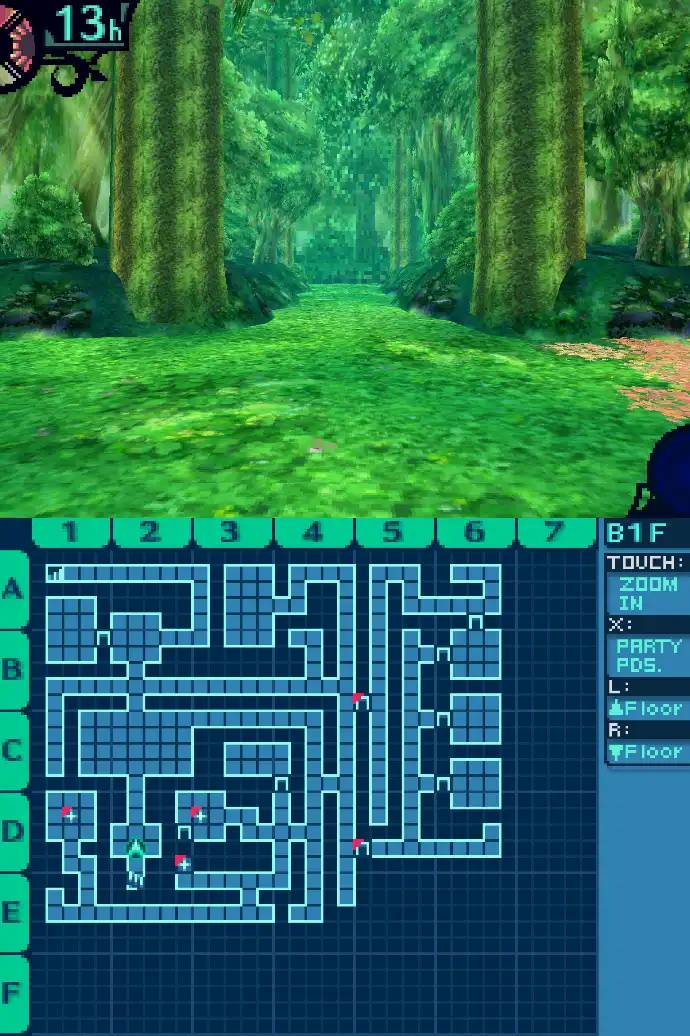
The first steps you take in Emerald Grove, the first stratum of the Yggdrasil Labyrinth. The top screen shows the first-person dungeon view, and the bottom screen is the map.
The aesthetic cohesion of the game is one of its strong points. Even though I played the game emulated on a computer with the game’s internal resolution pumped up six times what an actual DS can output, the art direction is good enough that its primitive visuals weren’t really a drawback. Each stratum feels like its own contained world with unique colour palettes, tiles, textures, and arguably most importantly, its own music. Yuzo Koshiro, known for his work on the Streets of Rage series, composed a beautiful soundtrack marked by its gorgeous FM synthesis sound palette. The songs are accurate representations of the zones you find yourself in: the first stratum, the Emerald Grove, is exceedingly verdant in its forest appearance, and the song is fittingly pastoral and lighthearted. The second zone’s nocturnal quality is reflected in the song’s slight mystery and lower energy, and so on. Not even mentioning the battle themes, particularly the endgame themes of insane energy and suitable climactic tone. Koshiro really did the game justice.
Mapping
This dualscreen presentation is very intuitive and feels like a natural fit for Etrian Odyssey, which is one of the main strengths the game demonstrates. Your map is slowly fleshed out with each step you take and it is endlessly rewarding to look back on your work. That is, assuming you mapped it correctly. The game gives you a small selection of tools for your cartographic needs: essentially one icon per type of landmark or feature, a paintbrush for mapping the walkable tiles, a pencil for the walls, and an eraser for each of these. There is an option in the menu for the game to automatically map the tiles you walk on (but not walls or anything else), but I opted to play 90% of the game with automapping turned on because I feel having it turned off might interrupt navigation too much. You’re either painting the walkable tiles in every step you take, or trusting that you’ve counted the number of steps you took accurately and then painting them in en masse. I’m sure you can see where the problem arises. However, I do think playing with the automapper turned off might be a cool challenge in its own right. There is an obvious "step" sound effect for each tile you walk so it’s unmistakable how many tiles you’ve walked if you keep an ear out.
I had never played a game with manual mapping like this before and was surprised at the new challenges it presented. Pretend you’re walking along in the dungeon and you come to a crossroads. You can see a ways down each path ahead of you. You decide to preemptively map these paths to save yourself the trouble of walking on them and the risk of a random encounter you mightn’t be prepared for. How long is the path? That depends on how good your depth perception and pattern recognition is. You might be able to accurately map it if you can read how many times the floor texture repeats. Or maybe you’ve been playing long enough and you can feel how long the path is, given that every tile is a square whose side lengths never change. Preemptive mapping is a skill that can be honed whose rewards might not be as great as I initially thought. Nonetheless, it certainly was a brand new experience for me, and one that I didn’t see coming. Because you’re drawing your own maps there is almost an interesting metagame present, where your success in navigation is determined solely by the player. To put it bluntly: if your map sucks, you’re gonna get lost.
I had a revelation recently when I played Shin Megami Tensei V. Now, I barely play open world videogames, so I don’t have much experience with this idea so it’s probably not new, but I thought it was very impressive that the developers of that game were able to make the actual traversal of the world more difficult as the game progressed for the fact that it’s a fully 3D world with smooth movement and voluntary battles. You think you can just run away from the encounters all game, which is technically true, but then the terrain becomes a challenge in its own right. The first area is clearly more easily traversed than the third, for example, with the latter being probably the most confusing area in the game for all of its unclear progression and jumbled, uneven terrain. It’s easy to get lost there for how messed up the world is: collapsed buildings, twisted steel, sheer cliff edges, a real mess of a location. I thought it was so cool that they managed to pull that off in a 3D world, and it really made me think about where Strange Journey ended up going towards the end with its world design. Etrian Odyssey follows the same convention where the final areas are absolutely full of traps and they basically throw everything at you, especially when you hit the postgame dungeon. Simply put, dungeon crawler movement is easy. You move step by step and turn 90 degrees left or right sometimes. The fact that the difficulty then manifests in the form of tricks and traps is intrinsic to the genre. The design choice to make some of the levels as difficult as they are is because of the fact that movement is simple, and that your map is always open and is just one eye glance away. The player has all the tools at their disposal, all within arm’s reach, which means you end up focusing on navigation most of the time, since you don’t have to think about quick reflexes, aiming a weapon, and so on. The labyrinth becomes a puzzle itself. While I do genuinely enjoy this, this is also where the game’s age kind of shows, and not for the fact that I’m writing this a little over fifteen years after this game came out. It’s a dungeon crawler. This type of game was nearly thirty years old on release. There is only so much you can do with a grid-based dungeon crawler, especially one whose movement and combat is still turn based. This kind of game has a niche audience from the get go. Thankfully, Etrian Odyssey manages to shake up the formula enough that it feels like a fresh experience, and this manifests in the form of its FOEs.
FOE

A FOE too close for comfort. Enjoy your new fear.
Aside from mapmaking, Etrian Odyssey is also known for its FOEs. No, not foes. Eff oh ees. Depending on the version of the game you play (in regards to its release region), this either stands for Field On Enemy, which makes sense, or some bizarre Latin backronym: Formido Oppugnatura Exsequens, or Foedus Obrepit Errabundus. They are tough enemies that pose a real, imminent threat. When it comes to RPGs as a whole you might have come across discussions about whether a game should feature random encounters or voluntary encounters, and the pros and cons of doing either. Etrian Odyssey proudly asserts its uniqueness and strengths for the fact it has both: random encounters are what you expect, and its voluntary encounters are with the FOEs. Yet it is not so simple. Most FOEs are deployed as a kind of metapuzzle on top of the dungeon crawling: they might move in a certain pattern, follow a path, or they function sort of like in a stealth game where you need to avoid their line of sight and sneak past. I genuinely had a great time seeing what new puzzle the game was going to throw my way, especially when it was in the form of a unique FOE setup. FOEs are genius and are one of the best strengths the game demonstrates. They follow the same rule as the player, mostly, in that they move around the labyrinth step by step, and if you manage to run into one (or they into you) it plays out like a battle. The enemies are generally much tougher than your average forest fodder, and you are most likely not prepared to take them on when you encounter any new ones for the first time. They present a real danger to the player, and an exciting one at that, for the fact that since movement is tile-by-tile, you could almost say that movement is turnbased, as well — there were moments where I would try to calculate a FOEs movements several tiles ahead to see how I could plan my escape. This is especially required in some of the more difficult FOE encounters.

Lord have mercy on my soul.
Warning: Light spoilers ahead.
Some of the FOE encounters are fiendishly difficult and some of them present an innovative challenge. This image above I’m pretty sure is from what I felt was the hardest floor in the main game: B20F. You have to fight fourteen FOEs in a row and then a proper boss. Fourteen. FOURTEEN. It’s messed up. All FOEs respawn after some amount of ingame time, dictated by the clock in the top left corner of the top screen, and this floor is where that fact becoming blindingly obvious. If you exit the labyrinth they all respawn instantly. If you take too long to kill them all, they’ll start to respawn anyway. You have to bait each FOE one at a time, defeat them in isolation, bait another, etc, until they’re all gone, and then face the boss. If you don’t think about your movements carefully, the situation like the image above can happen easily. And you may as well discard your current attempt at that point. It was brutal, but it was fair. You had to think carefully about your movements and consider your plan of attack carefully instead of just waltzing in and killing everything in sight. These puzzle implementations of FOEs are genius. My favourite is B27F, but holy hell is it tough to figure out.
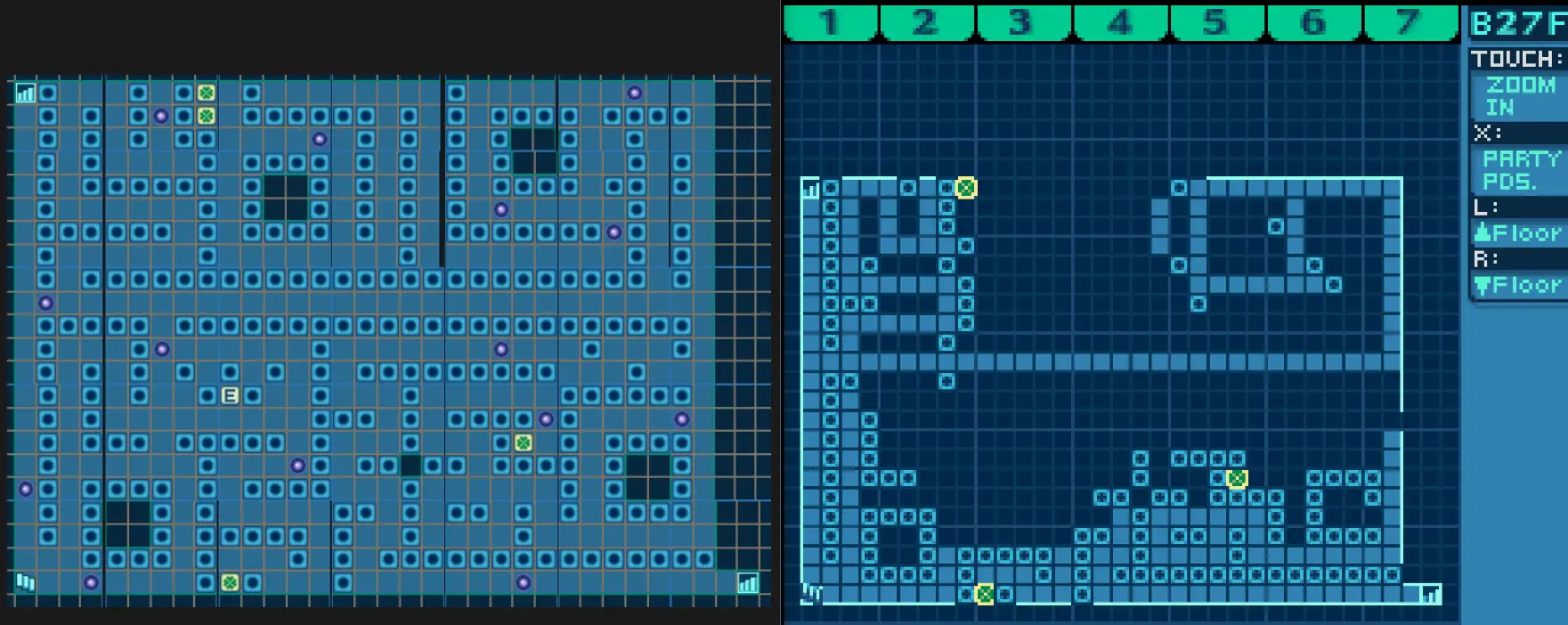
On the left is a complete map of B27F from the internet (those black lines are layout errors, just ignore them). On the right is my sorely incomplete attempt at translating that map ingame — the game’s icon limit prohibits you from making a complete map of this floor.
Limitations
B27F is a perfect example of what endgame nightmare difficulty is like in a dungeon crawler like this, but also for the game's limitations. That whole room is a pitfall maze. What you’re supposed to realise is that the several FOEs in the room actually patrol the safe path through the room. It is entirely possible to take careful note of where the FOEs walk, assuming you manage to avoid them at the same time, and map the safe path yourself, which I think is very clever. However, it also shows one of the worst problems I have with the game. For the fact that mapping is the core of the game:
- The game doesn’t give you enough icons to map every type of landmark.
- The icon limit per floor imposes a tough restriction on any attempt you might make to circumvent the narrow range of available icons.
In that image above you can see my attempt, on the right, to translate a map I found online, on the left, ingame. That image on the right is how far I got into mapping before the game’s icon limit kicked in. You literally do not have enough icons to work with to accurately map what the game presents you. Even though you can work around it, this still sucks.

All the pitfalls have been replaced with blank tiles in this workaround.
This is the workaround I ended up using for my playthrough. I made every pitfall a blank tile and only retained the walkable tiles. It was simple enough to devise this fix, but I don’t think the onus should be on the player to come up with their own solution to circumvent a problem the developers didn’t think to fix themselves. Yes, this solution works. Yes, I like the fact I was able to come up with a solution and that I think emergent gameplay styles outside of the "rules" of a game are cool. But I don't think it works when the only reason why the emergent gameplay happened was because of a seemingly baseless limitation of the game. I liken this to imposing artificial limits on yourself during a game if you find it to be too easy, but that the next difficulty level is bullshit. There are other ways of suggesting the player devise their own solution to a problem. I liked this in Strange Journey’s dark zones that don’t get automatically mapped until you find an upgrade to do so, so until then, you actually have to do it yourself — personally I used spreadsheet software to create my own maps. In Etrian Odyssey though, it’s one thing to come up with a solution to circumvent a limitation of the game when you just haven’t been given the tools to do something, and another entirely when that solution isn’t enough in itself.
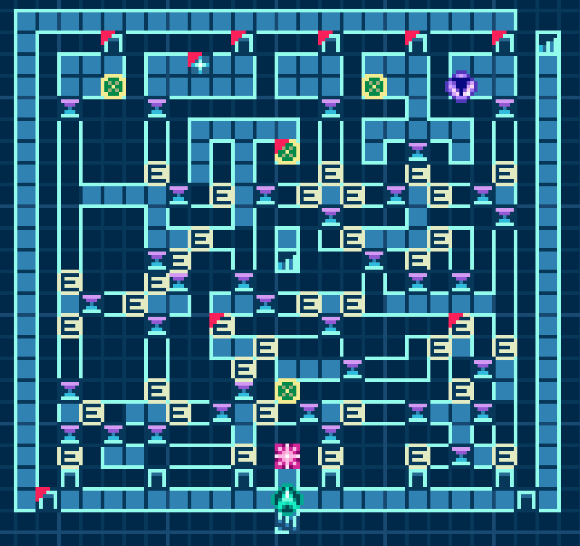
You REALLY have to get creative sometimes.
B16F is the first floor in the game in which conveyor belts are introduced, which are another staple of grid based dungeon crawlers. Turns out there are no icons to use to actually map conveyor belts, so that image above is my way of mapping it out myself — an Event icon for the start of a conveyor belt, a Warp icon (the one with purple and blue triangles) for the end, and blank tiles with walls for the middle. It worked. It’s ugly as hell, but it worked. It seems that later games in the series would get much, much better at providing the player with options for mapping; Etrian Odyssey Nexus supposedly has more icons than the player knows what to do with, enough that there are icons that don’t actually correspond to any landmark ingame. I haven’t played any of the games in the series past EO1 so I can’t speak from personal experience here. There is also no way to map damage tiles in a satisfactory manner. I ended up opting to paint the safe tiles in manually and leave the damaging ones blank, which is a dirty fix at best. Don’t try to put an unused icon for every damage tile either, as you’ll probably run into the icon limit. These fixes, while satisfying when they work well, are clearly an unintended side effect of the developers not foreseeing these issues. Some of them really make me wonder why. I can understand if for some reason the icon limit per floor couldn’t be fixed, perhaps because of a hard-coded issue that would break the rest of the game, or maybe a limitation of the Nintendo DS itself, but I find it very hard to believe the developers put conveyor belts in the game and then no icons for conveyor belts. This is a symptom of the most obvious problem with the game, which is the fact it is the first in a series. There are many parts of the game that feel crippled in some way as a result, which I will talk a bit more about later.
Combat
I’ve spent all this time talking about navigation and mapping simply because I think it is the most interesting part of the game. Combat, while it definitely does have some depth to it, pales in comparison to the cartographic fun of the game. It’s your fairly standard turn based affair. You can have a maximum of five members in your party, arranged across a front and back row with a maximum of three in one row. There are a total of nine classes to pick from, which are:
- Landsknecht
- Dark Hunter
- Survivalist
- Protector
- Medic
- Alchemist
- Bard
- Samurai
- Hexcaster
You get access to those last two fairly late into the game, which is a shame, but the remaining seven provide enough opportunities for interesting party composition. Everybody can be used on the offense, but it doesn’t seem to be ideal. I thought these classes provided a pretty satisfying range of skills to cover all your needs. Some of them are primarily offensive, some are primarily defensive, you have physical attackers and magic attackers, healing, support; it may as well be standard JRPG fare. But where Etrian Odyssey’s combat shines, in my opinion, are in its unique classes. I won’t talk about them all, but take the Dark Hunter, for example. Their primary weapon is a whip which can be used to inflict binds on enemies, which renders the enemy immobile or silent, and they cannot use their unique skills, but they can still do the basic "attack". You can bind an enemy’s head, its arms, or its legs, corresponding to the fact that each skill ingame has an associated "body part": magic spells are "head" skills, presumably because you use your…mind…to cast them; sword slashes, punches, and so on are "arm" skills, and if something does a big kick (or I think if an insect has any physical attack) it counts as a "leg" skill. The Dark Hunter has one skill each for these respective bind moves and another named "Ecstasy", which deals insane damage once all three binds have landed. I should mention that the bind skills deal physical damage regardless but their binds don’t land all the time. It becomes an RNG race to see if you can get all three to land before you use the big finisher. It’s really exciting.
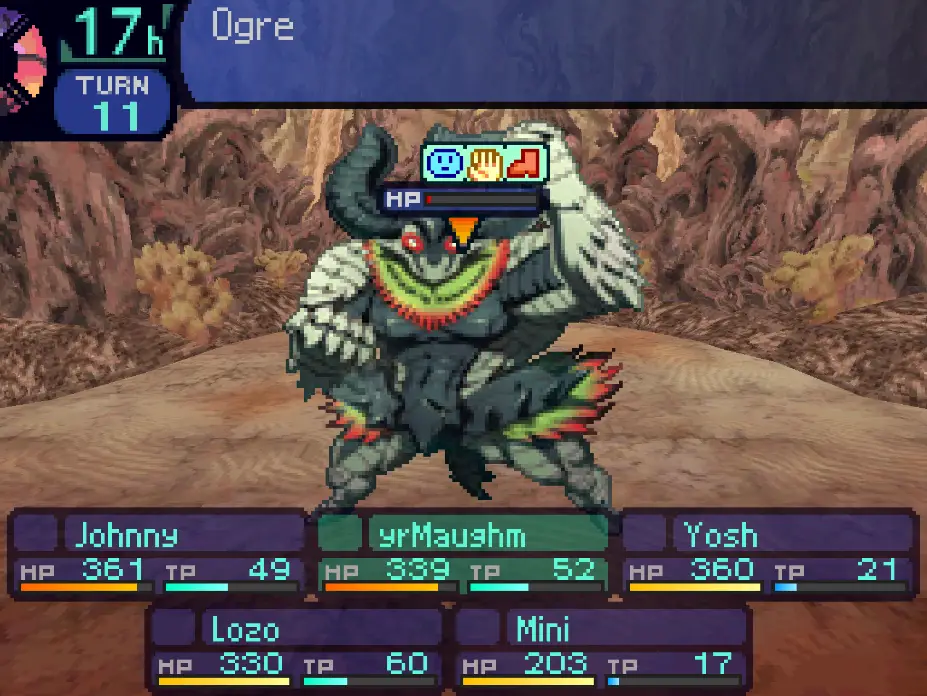
This poor Ogre is about to meet his fate. All three binds have landed as shown by the icons above him.
Most of the time I found combat to be pretty fun. You select each party member’s skill and then battle commences, the turn order mostly being determined by the skill’s inherent "speed" stat in conjunction with other battle variables and the caster’s speed themselves. You manage your health and TP (this game’s mana) in a manner that is fairly expected, utilising support items as you need and maybe a buff here or there. It’s fairly standard stuff. You also can "boost" your skills, which is based upon a meter that slowly charges up for every battle you do and resets when you leave the labyrinth. Mostly it means that your next selected skill will be way more effective. What is actually interesting though is the capacity for some insane party compositions. I can tell this game would satisfy any minmaxer out there. You don’t even have to use every class in the game to get through it; barring the Samurai and Hexcaster, I never got a Survivalist and made it through the main game.
However, combat is unbearably slow. I don’t think I’d ever used an emulator’s speed-up function as much as I did in Etrian Odyssey than in any other game previously. Skills that hit the entire enemy party show the damage-taken animation per enemy rather than one big blast, which is something that didn’t change I think until EO4. It must be a platform/engine limitation. But regardless I just think the combat took too long. Even if you pick your options in the menu fairly quickly, waiting for each animation to play out was, most of the time, excruciating. I’m glad I emulated this game instead of playing it on an actual DS, for various reasons, but this is probably the biggest one. With the speed-up at my fingertips, the combat is enjoyable, albeit a little mindless at times. After the early game slog and once you get into the groove, you can tell what’ll work and most common enemies don’t really throw any curveballs. There are some however which I think are just unbalanced and can totally wipe you too quickly. These are few and far between, which perhaps was a deliberate choice so as to keep the player on their toes, but it’s hard to tell if it was deliberate or not. Not to mention, anything I say in regard to this is because this was my first Etrian Odyssey game, this entry is known as being "the one with bad quality of life options" and that "some stuff is just broken." Later games in the series are supposedly more of an overall better time.
Most of the obvious problems of the game are in its combat or related systems. Some skills are straight up bugged and do not work as intended, and some are broken if you level them up too much. And on the flipside, some skills are simply too good. Using a maxed out and boosted Defender skill from the Protector and the same with Immunize from the Medic means that all incoming physical damage will be reduced to 8% of its original. It’s busted. Even without the skills being maxed out and boosted, their use in conjunction with each other will still trivialise a lot of battles. It may as well be an Easy mode switch, if not for the fact that it’ll last five turns before expiring. Additionally, the skill tree is very poorly laid out. It doesn’t show how skills interrelate given the fact that some are prerequisites of others and that they’re not visually grouped in any meaningful way. They are ordered in a meaningful way, but I think there is a reason why a tree looking diagram or some such is the de facto standard nowadays. This is just awkward.
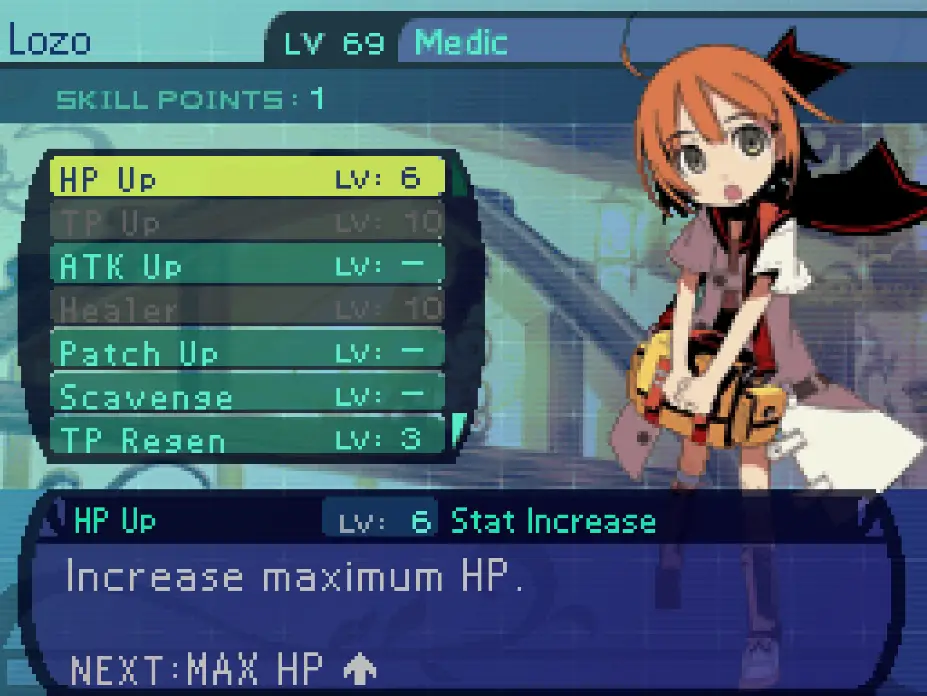
It’s not so much a skill tree as it is a skill list.
The actual progression per character, in terms of skills and XP, is not the best either. While I don’t mind an RPG that takes its time to level up each character, when considering the fact that there is no XP sharing (i.e. characters you’re not using right now don’t passively get XP), this is just painful. I made it to the third stratum before realising I probably need a Bard. So, I had to grind twenty levels on them. Thank god it’s easy to grind in the third stratum and you better believe I had the emulator sped up the entire time. But then melonDS ate my save and I lost four hours of game progress and two of grinding, which almost killed my playthrough then and there. But, I managed to turn it into a fun stream. And in retrospect I should’ve just cheated some levels in. The respec situation is dire too for the fact that you have to sacrifice 10 levels to be allowed to redistribute skill points…I think. I never actually did this myself because I did not want to sacrifice 10 levels, ever. I also made it to the final boss woefully underlevelled, and instead of grinding for five or six hours, I just gave up and used an XP cheat to put us on the same playing field.

The first appearance of Kupala, the main Forest Folk character. She is the voice of her people in the game.
Endgame
WARNING: Big spoilers ahead.
I mentioned earlier that the game is pretty light on story, which I think is ultimately one of its strengths. This is not the same as the story lacking in some regard. It’s just that you don’t really get too much story happening until you hit the fourth stratum. But for what it is, it’s pretty good. Mostly, it’s the same deal as Pocahontas and then what Avatar copied: colonisers doing what they do best. Visil, the town’s chieftain, wants as much tourism and attention as possible on Etria for the fact it’s a big revenue stream. The Yggdrasil Labyrinth’s sudden appearance attracted adventurers from all over the world and Visil wants to maintain this facade, for the fact that it basically operates as conquest to be overcome — most adventurers perish within the labyrinth, and so there is no shortage of newcomers to want to achieve glory and fame by fulling conquering it. Visil thinks he’s doing the right thing by maintaining this lie so that the town can flourish, even by allowing (or hoping) any adventurers to perish within. Once he realises your party hasn't been killed off yet, he gives an order to eradicate the forest people so everyone can continue exploring the labyrinth, when in reality he wants them to finish you off. The quest reads:
Annihilate the forest folk: The humanoid race of forest folk must be eradicated to allow further exploration of the Labyrinth. If it’s us or them, it's going to be us.
It’s clearly written from the perspective of Visil and there is no room for you to disagree. You must accept the quest. The game actually forces your complacency in their genocide. I can really appreciate a game with the balls to make you do something obviously ethically wrong in order to make a point. I think of the No Russian mission in Call of Duty: Modern Warfare 2. It’s not glorified, it’s not gamified, it’s not presented as a good thing, but you don’t have a choice. I honestly thought the game was going to have two endings or something and this is where the split point would’ve been, but that ended up not being the case. The forest folk become common enemies of the fourth stratum, and they’re fairly tough, too. I think this assists in ensuring the forest folk are not seen as fodder to plow through, and instead it feels like you are actually warring against a race of people with their own subjectivity; it humanises them. Although, of course, if you return to the level later once you’ve levelled up, they don't pose a problem anymore.
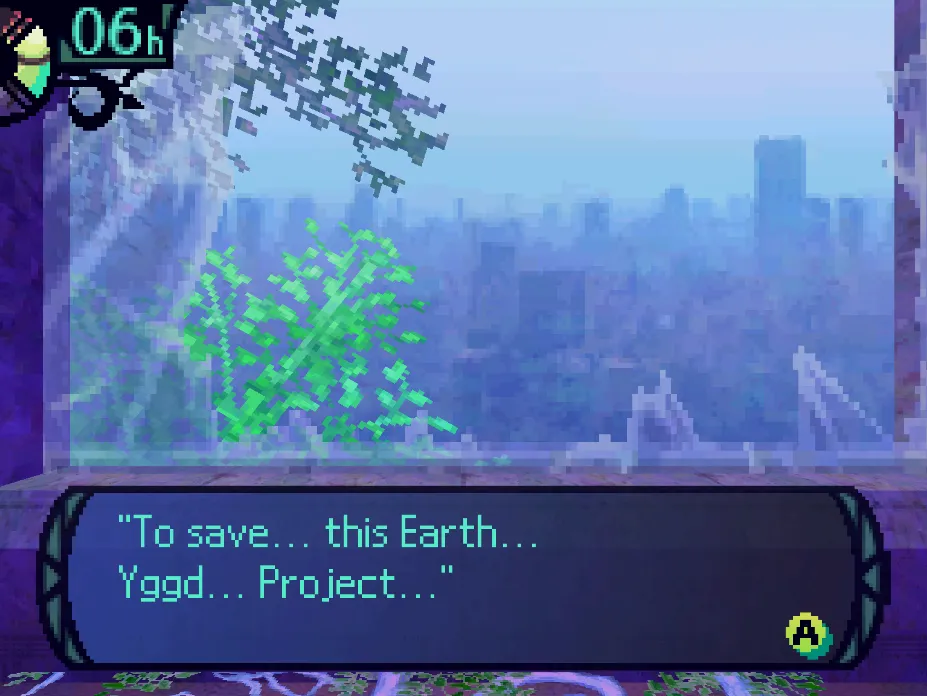
The build up to the game’s climactic story reveal is drip fed to the player via fittingly vague and incomplete notes you can come across in Lost Shinjuku.
The story really ramps up once you hit the fifth stratum, Lost Shinjuku. You feel something is amiss instantly from the name. All the previous strata were natural formations, like forests, lakes, deserts, etc. And this one is basically what amounts to an office building. Rectangular rooms, hallways, elevators, all old human technology. This tonal shift is one of the strengths of the game’s denouement. The twist unravelling isn’t sudden. Yes, you obviously realise that you’re not in another cool forest or something, but what the significance is is slowly revealed to the player via scraps and notes you can find in Lost Shinjuku, and not to mention their text is incomplete. The player has to fill in the gaps. Eradicating the forest folk, the town’s complacency, Visil acting strange… and then it clicks.
Surprise surprise, you’ve been on Earth all along, in the far distant future after the eventual demise of humanity, and Lost Shinjuku is one of the last remnants of the previous world’s existence. While not exactly new, it’s still an effective twist, and this time it is presented with more of a focus on climate crisis. The game is revealed to take place millennia after climate change has ravaged Earth, resulting in the death of billions. Visil oversaw the Yggdrasil Project, which aimed to cleanse the Earth and make it inhabitable once more. After being unable to ensure your deaths so as to not uncover the truth, Visil, in classic Resident Evil fashion, fuses with the Yggdrasil Tree itself and becomes the final boss of the game: Etreant.
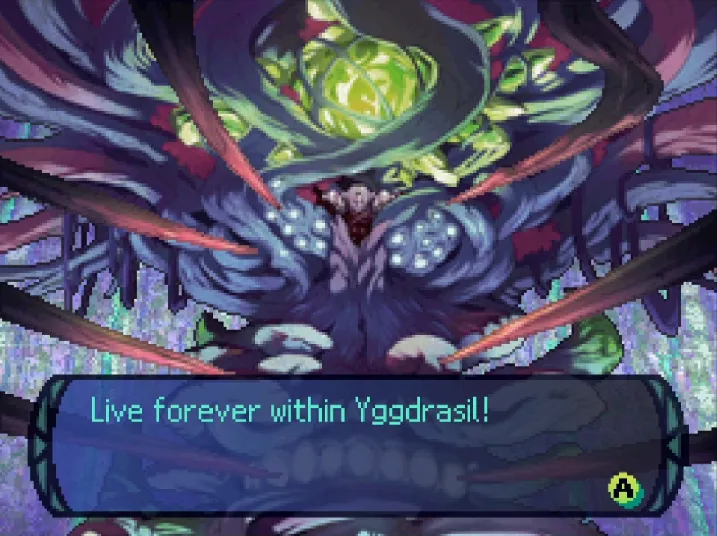
He means business.
My first attempt at the battle with Etreant went badly, surprising nobody. He wiped my entire party with one move, to which I sighed, and resigned myself back to the drawing board. I had neglected fighting the random encounters in Lost Shinjuku because of how much of a slog the stratum is. There are enemies that can easily kill your party in a few turns, the encounter rate is annoyingly high, the map itself is very complicated, and you don’t get proper shortcuts until you’re late into the stratum. I was woefully unprepared and underlevelled because I just wanted to power through the remaining portion of the game to be done with it. I believe I have neglected to mention that damage is calculated in the game partly based upon the discrepancy between the levels of the members of the parties in battle. My party was hovering around the early 50s, and I believe Etreant is in the mid 60s. Instead of grinding for six or more hours or so, I just enabled an Action Replay cheat and saved myself all that time grinding. Unfortunately I think I might have overlevelled, and I ended up trivialising the fight with Etreant. Even without using Immunize or Defender, he was not hard to kill. And it’s not like he wasn’t doing damage either; I was simply able to manage my team’s health and defenses well enough that the fight wasn’t challenging. This is one of the symptoms of why the end of my playthrough was unsatisfying, and it was probably my fault.
Postgame
After you kill Etreant you get a nice ending cutscene, the credits roll, and then that’s it. You’ve beaten the game. You can go back into to town and see what spoils you can get, but if you so desire, you can actually go back to Etreant’s boss room and find a secret staircase that leads to the postgame dungeon: Claret Hollows. Boy, if you thought Lost Shinjuku was a slog, you ain’t seen nothing yet. Claret Hollows is designed for Wizardry fans who don’t hate themselves enough yet. It’s filled with evil design choices: dead ends, too many one-way doors, pitfalls, damage floors, FOEs, and a myriad of other ways to reset your current progress. And not to mention tough enemies everywhere. I gave it a sincere try. I managed to clear B26F legitimately before using cheats of any kind and actually somehow enjoyed the pain, but holy hell that was enough for me. B27F is a pitfall maze (which should be enough to tell you how painful it is to actually map yourself) and B28F is a massive damage tile field that 90% of which you just fall into from above. I started using cheats on B27F to see if I could somehow push through and beat the postgame. I started to use noclip to make B26F a cakewalk for the fact you can just walk through a wall near your spawn point and enter B27F rather than have to do a teleporter maze each time. I also used noclip on B28F for similar reasons to just reach the next floor. Once I got to B29F and realised it was a huge teleporter maze, I just gave up. I was disappointed at the fact I trivialised Etreant and was hoping Claret Hollows could’ve been a cool way to wrap up the game, but turns out I don’t have the mental fortitude for maps as evil as this. I felt like I had finished a nice meal and now I was overeating on dessert.
I ended up just looking up what I had missed on B30F, the game’s final floor. There is a gauntlet of three bosses in a row before you face the true final boss, Primevil, who is the the core of the Yggdrasil Labyrinth. I’m glad I didn’t care to push onward for how much of a slog it looks like. Yet, I don’t think I can fault it for that. The game’s difficulty exceeded my tolerance. There is plenty to enjoy here, and if I was a more seasoned veteran of these types of games I probably would’ve enjoyed the challenge Claret Hollows presented. I don’t even think it was unfair, just brutal, which is a fitting summation of the series' take on difficulty. There is an enormous amount of things to do in the game. The postgame is even more on top of that. I had just had enough of this game and wanted to play something else. Perhaps I was burnt out on it? It’s hard to tell, but I don’t feel any burning desire to even attempt to clear B29F and B30F, let alone some of the (super?)bosses you can access in the main game once you beat Etreant. I actually attempted one, and he hit my whole party for 2500 damage each on the first turn. That’s when I put the game down.
The Nature of DS Games
I watched a review of this game on youtube soon after beating the game because I wanted to see what others said about it. One person said they found it to be a good "mindless" game, in that you could just pick it up, play it for a bit for minutes at a time, and put it away. With the knowledge that I thought the game was a slog at times, and realising that I may feel that way because I emulated it on my computer and by doing so played it for hours at a time, was disconcerting. I have felt similarly about other Nintendo DS games because I just do not find using the console to be comfortable in any way, which almost forces me to stop playing. I was taking breaks, don’t get me wrong, but I feel like this game was almost never supposed to be treated as a "deep" gameplay experience. Consider any AAA blockbuster or Ubisoft Masterpiece or whatever the hell the newest PS5 exclusive is. Presumably you can sit on a comfy couch and go and...I don't know, press X until you win or something, look at some nice graphics, walk around, and it's probably a smooth, yet boring, experience. In Etrian Odyssey, you go into a dungeon, map it out, kill stuff sometimes, and you do that's it. You might take a quest or two, which then entail going to the dungeon and finding something or killing something. The gameplay ultimately does not vary all that much.
I do not think that is inherently a bad thing. There are certainly games where they do one thing for the entire length, and they do it so well that you don’t want it to end. Or, it’s presented in such a good way that you don’t want it to end. Etrian Odyssey is sort of like that, but in my experience, the faults it presented did make me want it to end:
- There isn’t enough enemy variation. Once you hit Lost Shinjuku it's clear that there’s only a dozen or so enemy types that then get palette swaps.
- The limitations of your mapping tools is painfully obvious.
- The movement speed is too slow. I feel like the option to sprint could’ve gone a long way.
These are blindingly obvious symptoms of first-game-in-a-series syndrome. Ideas that sound good on paper don’t translate well to actual gameplay. I’m unsure how much testing or QA this game got, but it’s just so clear some things don’t work. Where it does work though, it works well. Exploration feels fantastic and is probably the best part of the game. Making your own map is very fun. The aesthetic consistency of the game is remarkable. The soundtrack by Yuzo Koshiro is excellent. The gradual story buildup feels natural and has a cool twist. There is a lot of content to do, if you want to, and I didn’t feel particularly underlevelled by not doing every sidequest, for example.
Everybody knows that Nintendo always tries to foster new gameplay experiences by creating consoles and input methods that go against the norm. Etrian Odyssey may as well be the best example of what was possible with the Nintendo DS. The dualscreen format means you always had your map open and it felt natural to do so. You could literally draw in your map, which is just, well, incredible. That is the core tenet of Etrian Odyssey. It feels like it is so locked to the DS platform that anything else would be like trying to fit a square peg into a round hole. I did play the game with mouse and keyboard however, and that was pretty nice. But like I mentioned earlier, the gameplay’s eventual tendency to become monotonous is because I did not play this on a portable console, on the go, picking it up and putting it down only after twenty minutes or something. Yes, there are more than five other games in the series that do basically the same thing which makes me wonder if the developers eventually did change the gameplay enough to reduce the capacity for the game to become monotonous, of course in conjunction with quality of life improvements. Regardless, this game, the first in a series, is a step in the right direction. It was the beginning of what I’m sure would turn into a remarkable series that corners a niche and owns it.
